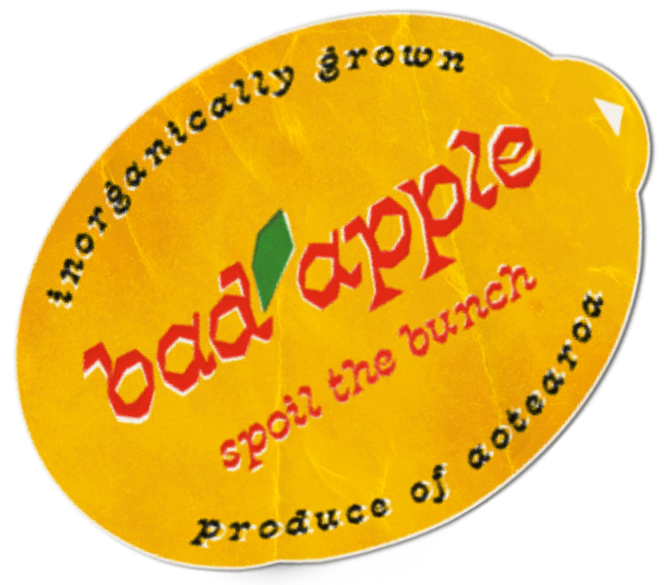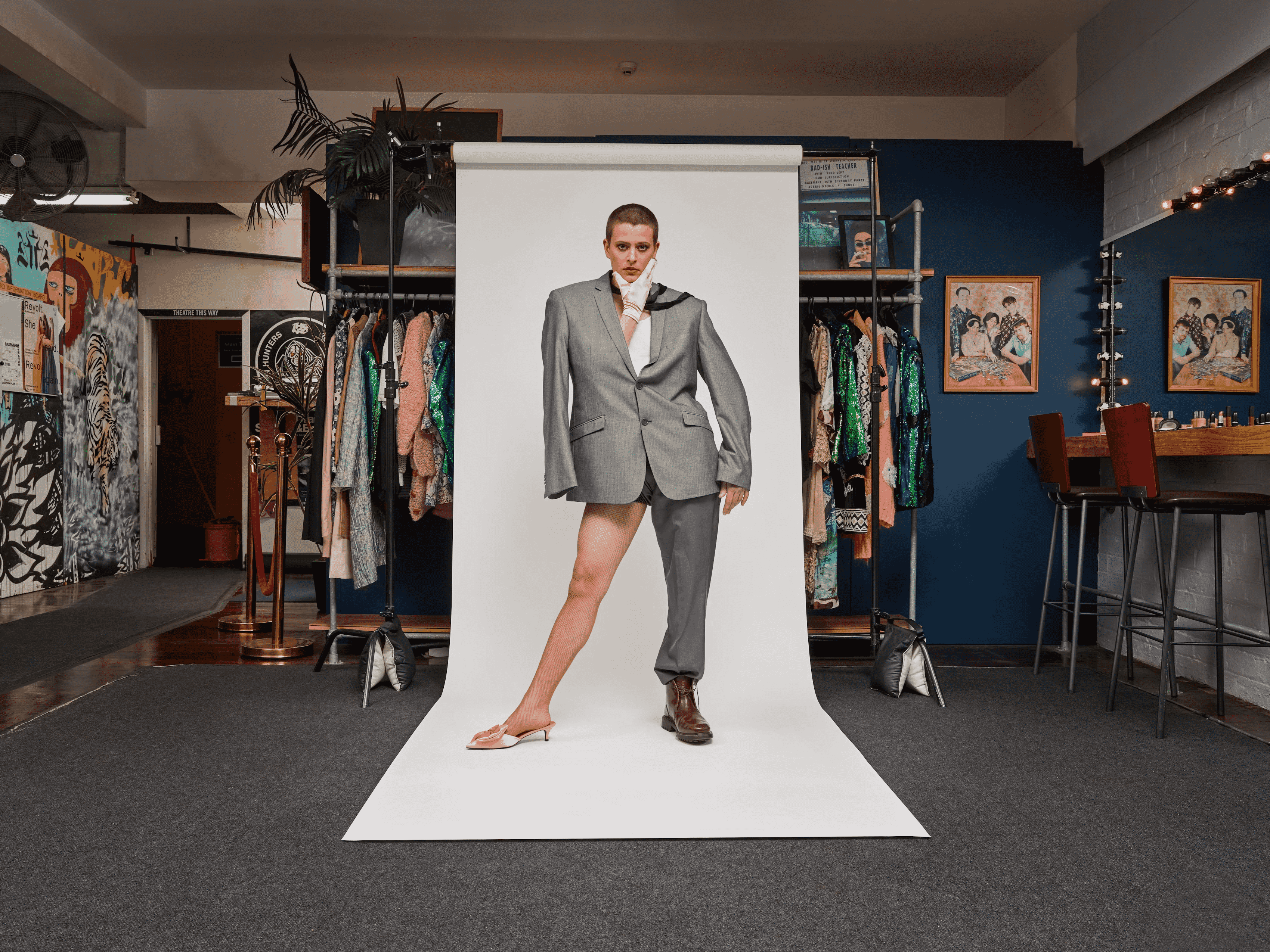Freya Silas Finch (they/them) is a performer, director, theatre-maker and cook. They began their theatre journey creating site-specific, experimental works such as Shabbat Shalom and Thank You For Coming. Their notable mainstage performances include Break Bread for Silo and Rosencrantz and Guildenstern Are Dead for Auckland Theatre Company. Freya is one of ten directors currently part of A Wave in The Ocean, Dame Jane Campion’s pop-up film intensive. They live in Maungawhau with their partner Cello Forrester and their pet rock (it’s quite big).
Ahead of the premiere of Freya’s solo show, A Slow Burlesque, Tate Fountain sat down with them to discuss the work, their creative process, and the other projects they have on the go. At a now-obscured point in this interview, Freya and Tate also realised the former was one of the associate tutors when the latter went through Auckland Theatre Company Summer School, many aeons ago. (Tāmaki Makaurau, are we right!)
TF: Thanks for meeting with me, Freya—this is so exciting; I’m really looking forward to the show. How are you feeling ahead of opening?
FSF: I feel good. We’re a week and a half into rehearsals, so, yeah, having lots of fun, and exploring, experimenting, and—yeah, feeling good.
TF: Great! So what’s it been like building the world of A Slow Burlesque with your collaborators? [Jo Randerson (Direction), Sophie Roberts (Dramaturgy), the Design team (Bekky Boyce, Lighting; Kirsty Cameron and Tautahi Subritzky, Costume; Talia Pua, Set), Josie Archer (Choreography).]
FSF: Well, it’s been in some ways quite a long process, because I started creating the work with Silo on board almost two years ago now. There have been different facets to that, but a big part of it this year was a last push on devising the show, and then I did a lot of work with Kirsty Cameron, who’s done costumes. We spent quite a bit of time together because that’s a really big element of the show; there are eight or nine costume changes or something. Now we’re at this stage where we’re all in a room together staging it, and detailing, and working with lights, set, music. [It’s been] a long journey.
TF: Those eight or nine costume changes—that was going to be one of my questions. I’d heard talk of ‘lots and lots and lots’ of costumes, and I was like, ‘Just how many [are we talking about]?’ […] With all of those costume changes, I’m sure, narratively, they weave into the work—what does that weaving look like, and how does that intersect with the onstage action? What can we expect there?
FSF: The whole thing is that you see the costume changes happening; there’s no wings. I guess I wanted to explore the costume change as the action, as the theatre, rather than— y’know—that bit’s always hidden from an audience. I mean, there are a couple of clever tricks and stuff, but other than that, we don’t really hide that part of it; we see me transforming from one character to another.
It’s also not really a very logically narrative piece; it’s quite absurd and surreal—there’s not really a clear story with a beginning, middle, end. It jumps all over the place, and the characters are kind of these larger-than-life exaggerations of, I guess, different personas I’ve inhabited, or masks I’ve worn through my life, or—they serve the function of personal storytelling but through a really exaggerated persona.
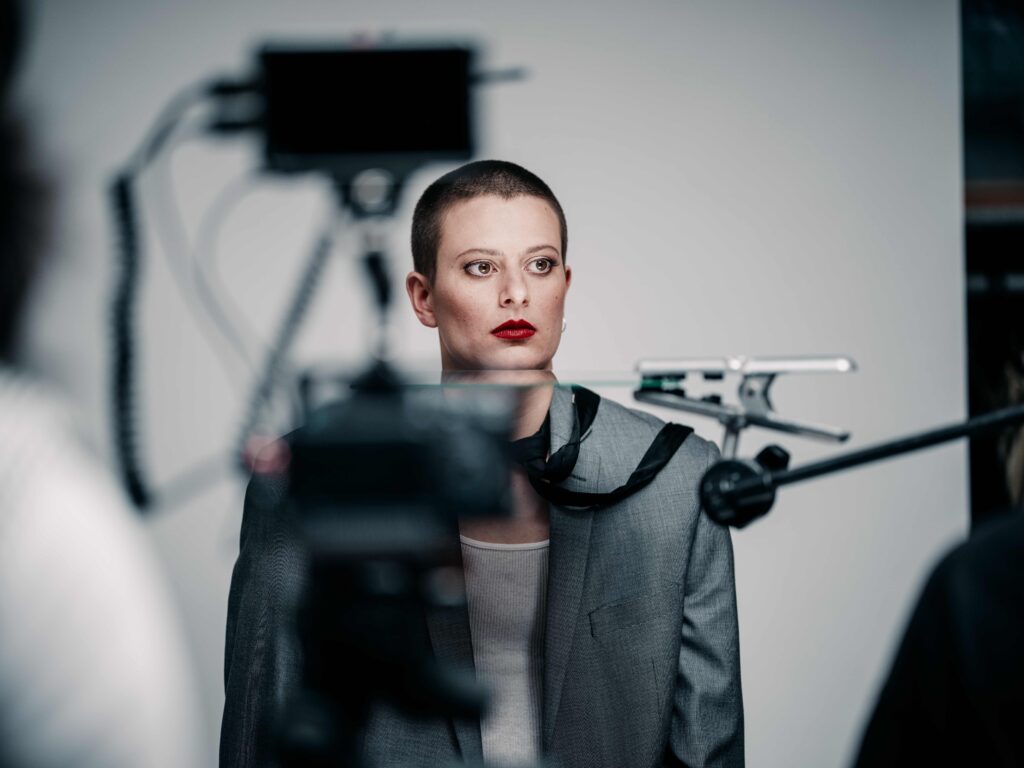
TF: I’m interested, then: where have you sourced [these costume pieces] from? Are they Silo wardrobe pieces? Have they been found bespoke?
FSF: That’s been the big work that Kirsty’s done—Kirsty Cameron and now Tautahi Subritzky, who is also designing and assisting Kirsty. [The pieces] have come from all over the place; those guys trawled vintage stores and opshops. And then Kirsty had pieces from, just—y’know, she’s been a costume designer forever, so she’s just collected things over the years. I think some are from Silo, some are from [Auckland Theatre Company], all over the show; some have been constructed for the show as well, from scratch.
TF: With the process of developing this show over the past couple of years, what’s changed from your initial conceptions of what it might be? What’s stayed the same?
FSF: That’s a great question. I had the very initial idea for this show ten years ago. And it was a long time before I started making anything, but when I initially thought about this idea, it was one costume change, from a very ‘femme’ character to a very ‘masc’ character, and it was very A to B. And, y’know, I was, like, 18, 19, when I had that idea, and I think, in my mind, that was the only way I could explore gender—was to go from one binary pole to the other. And so what’s interesting I guess is that the show has changed and developed as I have through my twenties. Now, it’s this much more fluid . . . we go through all kinds of gender expressions, differently gendered characters. So that’s a huge change, obviously, that’s come to reflect me—or my thinking, more, or something. At that age, that was how I was thinking about that, which is not how I’m thinking about it now.
And then more specifically, there are all sorts of pieces [of the work] you let go of—there would be whole characters, or, I don’t know, a little piece where you’re like, ‘Okay, maybe I’ll do this thing with this skirt,’ and you try it and it’s like, ‘No, it doesn’t work.’
For this one version of the show we’ll arrive at for Silo, there probably are ten other versions that passed away at some point. (Laughs.)
TF: So now that you’ve had some time in rehearsals, are there any standout moments that you’re holding onto from the past couple of weeks? Any discoveries you didn’t expect—or something that made you laugh?
FSF: I mean, it’s a really fun room. Working with Jo [Randerson] is really fun, and they crack me up all the time; I’m having a lot of fun with that.
But there’s a character I’ve become really fond of. They were one of the characters, going into rehearsal that I didn’t really love—or it’s not that I didn’t love them, but I was like, ‘Ah, I don’t really know what this character is; why have I written this part?’ And now I really love them—this Yorkshire punk poet who just waxes lyrical.
Yeah, it’s funny—sometimes the bits you really love . . . I don’t know, you go through waves with them. Sometimes you love a bit, and then a couple of weeks later, you’re like, ‘Ugh, I can’t stand that bit,’ and then vice versa. Kind of falling in and out of love with the characters, I guess.
TF: I think that’s probably something that’ll happen over the course of the season as well, as audiences come into the room and into the space.
FSF: Totally.
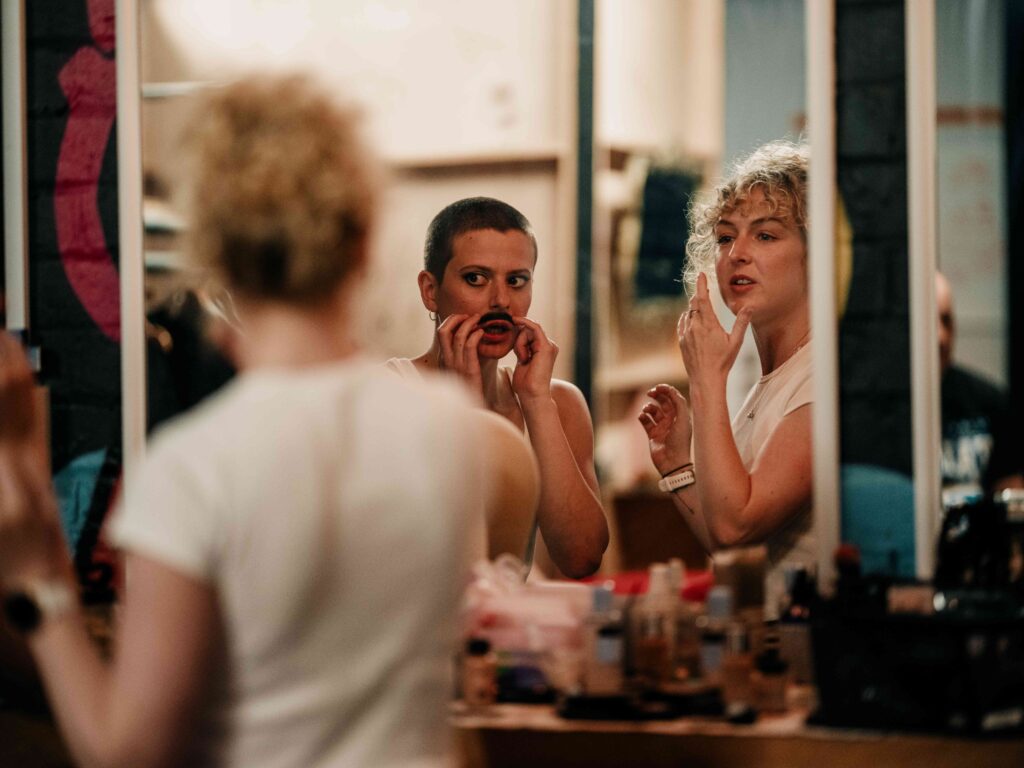
TF: So, I’m going to do something now that might be cringe, which is quoting you to you—
[Tate and Freya laugh.]
TF: But! There have been some quotes throughout the promotional material that’s been published already that I’d love to pick your brain about a little bit more. First, there’s the classic, “We’ve all been so fucking well-behaved recently. It’s time for people to get freaky and have some fun.” Have you been feeling that appetite shift with your own viewing habits, with your making habits?
FSF: Yeah, it’s so funny, I don’t remember saying that—
[Tate and Freya laugh.]
FSF: But, um, I did, apparently. Sorry, what was the question?
TF: Have you been feeling the appetite shift towards fun in your own viewing habits or making habits?
FSF: Yeah—I guess where me saying that came from, for some context, is wanting the show to feel really playful and wanting to end on a note where people feel really free and exploratory with gender. And I think—you know, there’s part of the discourse around gender that is obviously so utterly important, but can get very heavy and has been so politicised. That’s a really, really important aspect of it, but I think when that’s the only way gender is talked about, it turns a lot of people off to the conversation and I feel this pressure as a maker to produce a certain kind of work . . . I think a lot of trans people feel this—or just a lot of othered people, or minority people, feel this—of kind of being required to make this kind of trauma porn, essentially, and I just really don’t want to do that, so I’ve tried to make something that’s kind of euphoric and fun, even though there is a deeper message, and there are moments that are quite personal, or even moments that are very painful.
So that was what that was about: me saying, ‘Come and have some fun.’ It’s almost like, ‘Don’t worry—you’re not gonna come and be lectured at.’ […] I mean, it’s good to hear me say that, ’cause I think I can take myself and the work very seriously, when, this week especially, we’ve had a lot of funny moments—so that’s been cool.
I always feel like it’s this juggle with artmaking—but maybe this is even true for life—where you’ve got to be really serious and take it really seriously, and be like, ‘This is of the utmost importance.’ And then you’ve gotta be like, ‘This is so stupid, this is so silly, this is just a silly little dance,’ and you’re juggling both of those balls at the same time. And if that gets out of balance and you get too serious, it can be dangerous, but if it gets out of balance and you’re just taking the piss, it can be a bit dangerous, too.
TF: I mean, in a way, they’re what give each other meaning.
FSF: Yeah, totally, yeah.
TF: I also read an article that Sam Brooks put together for The Spinoff’s Art Work series, in which you mention a suite of activities that you do as a creative person, just for yourself, largely separate from your creative practice. Is that an important delineation for you, having something that’s just for joy, as opposed to for work?
FSF: I think definitely, eh. I think it’s two things:
Having pieces of artwork that I make that possibly no one will ever see feels really important. If everything you make, you put out, it’s like there’s nothing that’s sacred and precious for you—so that’s one part of it. There’d be all kinds of photos I’ve taken over the years, ’cause I love taking photos; I don’t think I’m ‘a great photographer’, per se, but I just love doing it—but I’ve never shown, like . . . I’m not taking them with the intention of exhibiting them, or something. So I think that’s one part of it.
And then I think another part of it is, like, the pressure’s off, y’know. Obviously, with this or with my filmmaking practice, there’s a certain element of pressure; you can try to pretend it’s not there, but it is. (Laughs.) To some extent. So it’s like, also having creative art-making things where it’s like, ‘If this whole roll of film comes back and it’s a dud, well, y’know, it doesn’t matter; there’s no deadline associated with it.’ I think it’s that for me.
TF: And I suppose that kind of practice—whether it’s photography, whether it’s drawing, anything that’s just for yourself—will inform the theatremaking and the filmmaking.
FSF: Yeah, they all interweave in interesting ways. I mean, the photography really helped me with the filmmaking because of the visual aspect and the way of looking at things—and then theatre and film have some obvious crossovers.
TF: I want to talk about your short film, actually! You don’t have to share too much, but I know that you’re balancing prep for that with the process of A Slow Burlesque. What can you tell us about it? Are you shooting it in Tāmaki? What’s the plan?
FSF: I’ll shoot it in November—I’ll roll straight off this into pre-production. (Laughs.) Yeah, I’m shooting it in Tāmaki. It’s very, very different to this show, which I’ve really loved—having two very different projects.
This show is super absurd, [with] a nonlinear narrative, and then the film is a very simple—I don’t want to say ‘traditional’—but it’s a simple, solid story. I won’t say too much, but it’s about a group of teenage boys who are grieving the death of a friend. It’s such a different world to this show. But as I said before, it’s been really nice to have two different projects, and probably a little bit of a nice confidence boost for me to be like, ‘Oh, I can do both.’
I don’t know if you feel this in your practice sometimes, but you might do a couple of things that are in the same world and then you feel a bit like, ‘Is this my thing now? Am I the so-and-so kind of person or whatever?’ So it’s been nice to be like, ‘Oh, I can do a weird, abstract theatre show and then do a quite straight narrative drama film.’
TF: And I think it helps you feed both sides of those things—it’s what we were talking about before, with the serious and the silly, a little bit. Sometimes the best work comes out of having been very specifically in one mode for a while, and then just looking at that and going, ‘Ah—fuck it—give me something else to play with!’
FSF: Yeah, the last few months have been fun because when I get sick of one of them, I just go and work on the other one.
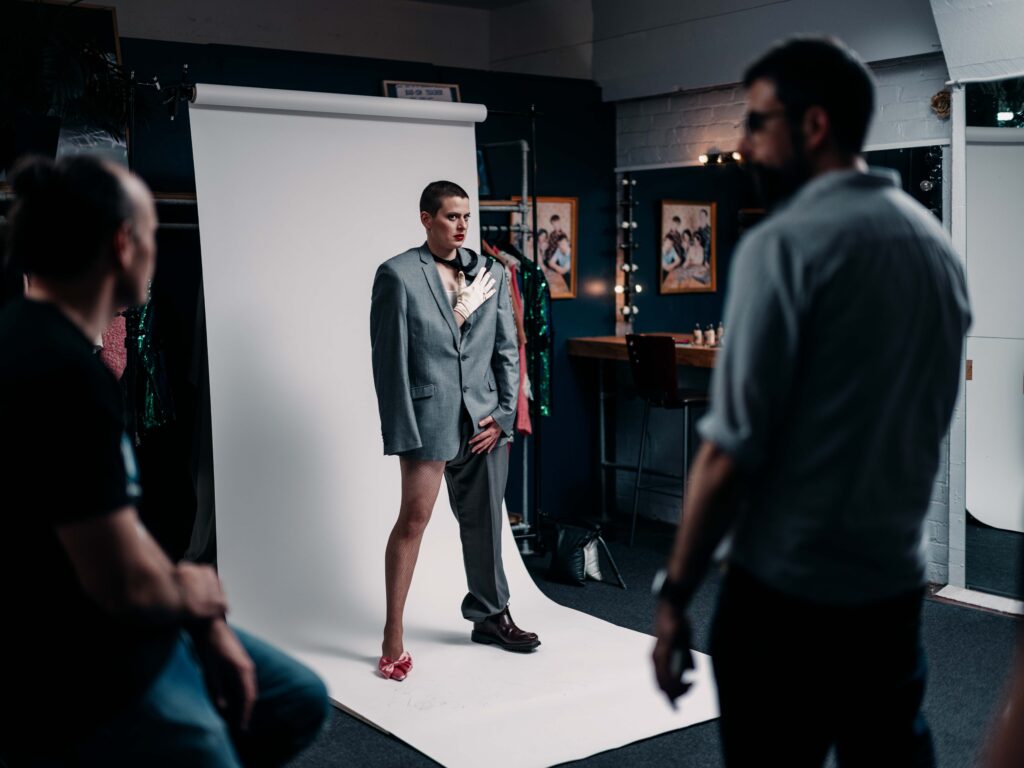
TF: Because the development process for A Slow Burlesque has been, essentially, ten years in the making, on and off, from idea to execution—has it been good to have (alongside other projects ticking along) clear endpoints or, like, scheduled happenings? So that you can’t just sit in the idea space?
FSF: Yeah, it’s so helpful. I mean, it’s scary as well, but it’s so helpful—because otherwise you just try to perfect something forever, but you never will, so at some point you just have to let it go and let it be what it is, with its imperfections. I’ve found that incredibly helpful this year, to just be like, ‘I have these two really clear deadlines for these two projects.’
TF: And what else—if you can say anything—do you have that’s bubbling away or in the pipeline? What might you want to explore next?
FSF: I have a few things on the back burner—I have a play that I’m writing with my partner, starting with the idea of a queer couple trying to name their child, and what it means to name someone. […] So I’m working on that. I’d like to keep taking photos next year, I’ve kind of dropped off doing that for a while. I’d also like to have a huge holiday and go travelling or something.
TF: Having a bit of time and having it be free can be—yes, scary, but also: that’s where the magic happens. That’s when things come up that you don’t expect.
FSF: Yeah, and I kind of like that—having a big busy period and then actually having a nothing period; I don’t see that as troubling. It’s a good rhythm.
TF: And, I mean, people talk about fallow periods, right—when you have this huge period of productivity, and then you have the period where you have to have those quieter times in order to build up life experience that then becomes ideas that then becomes work.
FSF: Exactly. You’ve got to go out and live, otherwise you don’t have any juice to make anything about.
TF: It’s like what gets said about stand-up comedians—that after a certain point, all they can write about is airports.
FSF: True! Lots of gags about airports.
TF: Finally, is there anything you’d like audiences to keep in mind ahead of A Slow Burlesque?
FSF: I think just come with an open mind. And—I mean, this is a bit boring, but probably is important that audiences come expecting something nonlinear and abstract and surreal; if you’re coming expecting a sort of, three-act play, you might get a bit of a surprise. And—there’s a lot of comedy! Feel free to laugh! It’s personal storytelling, but I welcome laughter.
This interview has been edited and condensed for clarity.
A Slow Burlesque, created and performed Freya Silas Finch and presented by Silo Theatre, will run from Friday 4 October until Saturday 19 October at Basement Theatre. Ticket prices range from $30 to $65 and are available to purchase from iTicket.
Direction — Jo Randerson
Dramatugry — Sophie Roberts
Design — Bekky Boyce, Kirsty Cameron, Talia Pua, Tautahi Subritzky
Choreography — Josie Archer
Featured photography — David St George
